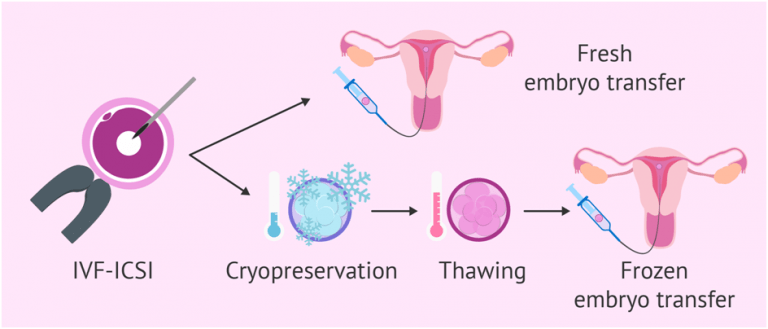Embryo transfer is the last step of the IVF procedure, during which your doctor transfers the embryos into your uterus. It is a simple process that doesn’t require anesthesia.
For many patients, it is the most thrilling and optimistic moment in what can be a difficult and lengthy treatment. However, you may wonder which is a better option for you, fresh or frozen embryo transfer.
The success rates of frozen and fresh embryo transfers and their advantages have been a highly debated topic. Many fertility doctors claim that using frozen embryo transfers via assisted reproductive technology results in more live births than fresh embryo transfers.
Dr. Hrishikesh Pai, one of the best infertility doctor in India, says that success rates are not the only deciding criteria. Choosing between a fresh embryo transfer or a frozen one depends on your individual case.
This article outlines the differences between fresh and frozen embryo transfers, their success rates, and the advantages of each treatment so that you can have a well-informed discussion with your fertility doctor.
What is the difference between fresh and frozen embryo transfer?

Fresh embryo transfer happens within a few days of the egg retrieval process after your IVF cycle of ovarian stimulation.
Once the eggs are fertilized with your partner’s sperm, the embryo is transferred to your uterus in three to five days. However, nowadays, most clinics allow the embryo to develop to the blastocyst stage before transferring, which is the fifth or sixth day.
Whereas during frozen embryo transfer (FET), embryos from your previous IVF cycle which were frozen and thawed are transferred to your uterus. It can take place after a month or years after the egg retrieval and fertilization cycle.
At Bloom IVF, one of the best IVF centre in India, the fertility specialist explains in detail the pros and cons of fresh and frozen embryo transfer and help patients determine which is right for them.
What is the success rate of fresh and frozen embryo transfer?

Many clinics have observed a higher success rate for frozen embryo transfer than for fresh embryo transfer. In recent times, there has been an increase of 15% in pregnancy rates for frozen embryo transfer treatment in India.
This is due to the advancement in the freezing, storing, and thawing techniques that have allowed frozen embryo transfer to close the gap. It was not possible a decade ago.
There are various aspects to consider when comparing the success rates of fresh and frozen embryo transfer.
When choosing between storing your embryos or opting for a fresh transfer, you should consider several things, including your age when freezing the embryos, the quality of the sperm used for fertilization, and your general health during both transfers.
The best guidance you can receive on which transfer would be best for you comes from an expert IVF doctor in India, like Dr. Hrishikesh Pai, having more than 35 years of experience in the field of reproductive medicines.
How to decide between fresh and frozen embryo transfer?
When deciding between fresh or frozen embryo transfer, there are numerous factors to take into account. One of the main factors is how you react to and how your body recovers from the stimulation drugs given before the egg retrieval.
The IVF doctor will recommend a fresh or frozen transfer depending on the results of a blood test that measures hormone levels like progesterone and estrogen, as well as an ultrasound to assess the condition of the uterine lining.
Most women can have a fresh transfer if their uterine lining appears good and the hormones are in balance. Further, fresh embryo transfer is favorable in terms of cost and time.
The doctor may suggest a frozen embryo transfer if the patient’s hormones are imbalanced, she has hyperstimulation, or her lining isn’t as receptive as it should be.
Doctors usually adopt a patient-centric approach to determine between fresh and frozen embryo transfer as each patient responds differently to the stimulation drugs.
What are the benefits of frozen embryo transfer?

Frozen embryo transfer offers several advantages that we have discussed below:
FET is less expensive
IVF is a costly procedure, and if your first cycle fails, you can use the frozen embryos for your next cycle. It will reduce the cost as you will not have to undergo stimulation and egg retrieval.
It offers the liberty to plan your pregnancy
By freezing the embryos, you can preserve your fertility. This allows you to conceive when you are ready.
Also, freezing your embryos before chemotherapy or other invasive treatments helps couples achieve their dream of becoming parents later.
Minimizes mental and physical stress for women
Undergoing IVF with fresh transfer involves steps such as ovarian stimulation, egg development and retrieval, fertilization, and implantation. This takes a toll on the women physically and mentally.
Whereas with FET, you do not have to go through the stimulation and egg retrieval process as the embryos are already ready for use. You will only need medications for preparing the uterus lining for embryo transfer.
Provides time for genetic testing
Frozen embryo transfer allows the fertility doctor to perform preimplantation genetic testing to evaluate the embryos for genetic defects before transferring them to the uterus.
It further permits the doctor to choose the embryo with the highest chance of implantation and pregnancy, thereby increasing the success rate and minimizing the chances of miscarriage.
For added information and advice regarding the best option for you, fresh or frozen transfer, consult one of the leading IVF doctor in India, Dr. Hrishikesh Pai. He is the pioneer of many innovations and techniques that have revolutionized fertility treatment in India.

